Co Down father and son team Noel and Richard Kane have started up a business making lime spreaders, called Spreadpoint.
Richard said they chose lime spreaders for a number of reasons. Firstly, they were looking out for a lime spreader for their own arable farm. After taking a look at what was on the market and what machines local agricultural contractors were using, they felt there was a gap in the market for a robust, well-designed and affordable lime spreader.
The pair, who are part of a well-know family that make trailers, also run a 1,000ac arable farm. Richard said they wanted to establish a micro-business to concentrate on in the quieter months of the year while providing the farm staff with full-time employment.
Timeline
Carrying a wealth of knowledge from the Kane family’s trailer engineering background, Noel and Richard decided to build a lime spreader two-and-a-half years ago. Eighteen months later they had designed and manufactured their first spreader.
Noel, Richard and their team have spent the past year fine-tuning the machine along with making design changes. The company has made seven spreaders to date.
Design
The spreader has a monocoque design, in that the chassis is integrated into the body. This is in an attempt to eliminate any flat surfaces, ensuring all material is sloping into the walking floor while also giving an added strength-to-weight ratio. The company opted for a 30° incline on the belt (higher to the rear of the spreader). This was to keep the centre of gravity as low as possible.
Richard said: “The belt will transfer the lime to the discs at the same efficiency at 30° as at 0°.”
Hydraulic drive
After opting for a land drive belt control system on the flagship model, Richard changed his mind and decided to use a hydraulic drive instead.
The hydraulic disc drive allows the tips of the flights to overlap between both spreading discs, increasing spreading width of lime up to 12 metres. There are four vanes per disc with each disc measuring in at 990mm (including the flights).
The beefy hydraulic disc unit has two 6mm stainless steel discs which are mounted on a synchronised gearbox and driven from one hydraulic motor.
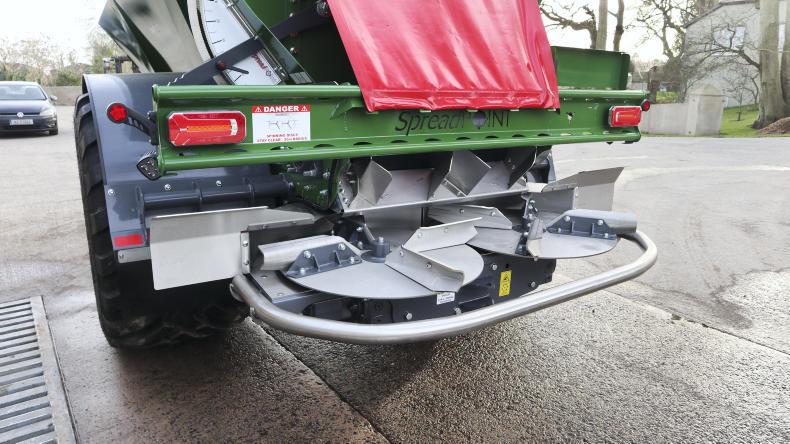
Both 6mm stainless steel discs are mounted on a synchronised gearbox and driven from one hydraulic motor.
The discs are submerged in a bath of oil for continuous lubrication.
Nylon sleeve
The rollers for the floor have a unique bearing-less and boltless design. Instead of opting for the standard bearings on each roller, Richard decided to use 20 individual nylon sleeves which rotate on 32mm stainless steel rods. These nylon sleeves slot into the chassis of the spreader. In turn, only the nylon sleeves rotate as the belt rotates. These rollers are positioned close together to ensure the floor will rotate as soon as the hydraulics are engaged. Richard said he went for this system in an attempt to reduce downtime.
The only bearings on the moving floor are on the front and rear tensioning rollers. There are a total of nine bearings on the machine which should be greased after every 50 hours of use.
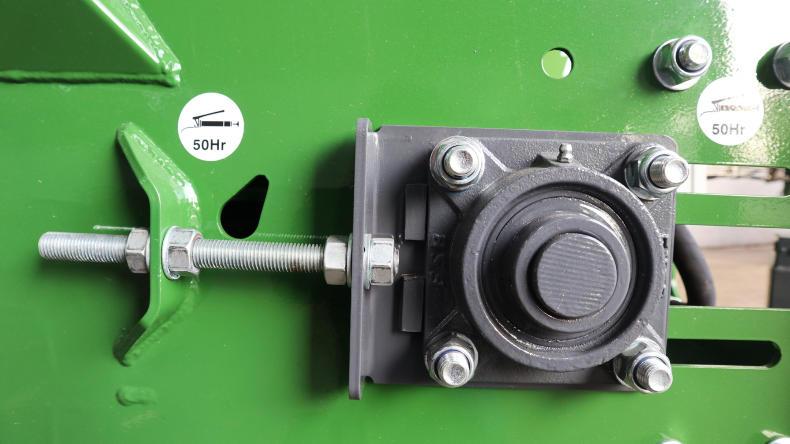
The only bearings on the moving floor are on the front and rear tensioning rollers.
RDS Apollo terminal
Richard opted to use the well-established RDS Apollo control terminal.
When connected to its own GPS receiver, this computer system will monitor the tractor’s forward speed and match the belt speed accordingly in order to reach the desired application rate.
The disc speed can also be set or adjusted from the control monitor
This target rate can be set and altered from the control monitor. The disc speed can also be set or adjusted from the control monitor.
By means of calculating what tonnage was initially loaded and what was spread from the set application rate, the terminal will also inform the operator how much lime is remaining in the spreader. The spreader is also compatible with all certified Isobus control terminals.
A button from the Apollo terminal can be retrofitted to the gearshift of the tractor. This button will trigger the belt to be engaged or disengaged. It is very handy for shutting off the supply to the discs while approaching a headland.
Features
The flagship model has a hydraulic back door to ensure no waste of material while loading or in transport. Once the door is preset, even when closed for loading or transport, it will return to its preset height.
One interesting feature is the hitch on the rear of the spreader underneath the discs. This hitch was added specifically for the Northern Irish and Scottish markets where many farmers pull elevators behind spreaders on the road.
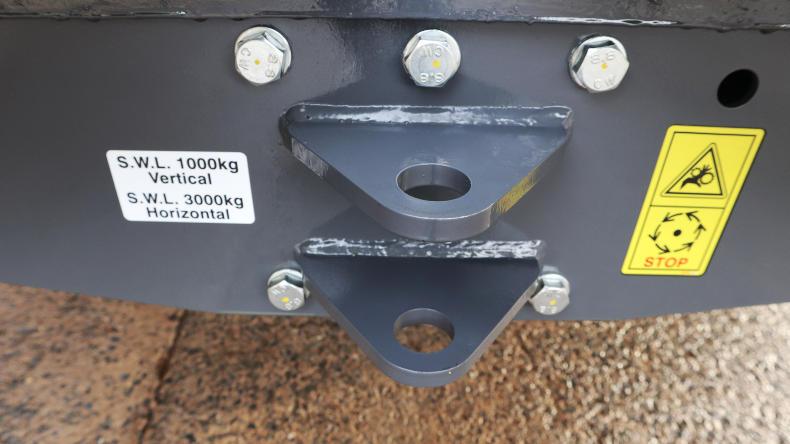
The hitch was added specifically for the Northern and Scottish markets where many farmers pull elevators behind spreaders on the road.
The spreader comes with a smooth belt in order to provide a consistent flow of material to the discs. However, it comes with the option of a cleated belt. Richard said they have used the machine to spread chicken litter on their home farm.
The SP600 comes as standard on a Granning commercial axle rated for a maximum speed of 50km/h. This has air and hydraulic brakes. The machine is equipped as standard with 710/50R26.5 tyres. It also has a sprung drawbar system.
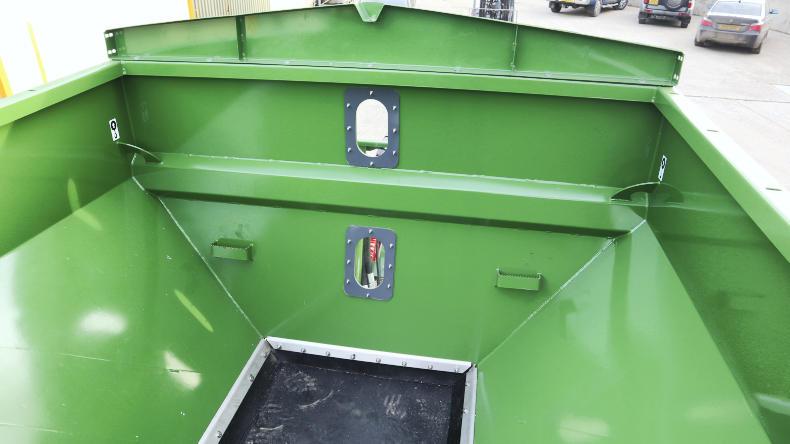
A nice feature is the two windows at the front of the machine. This allows the operator see into the hopper.
Other nice features include the steps either side of the sprung drawbar on to a platform, two windows at the front of the machine allowing the operator to see into the hopper, and a sloped storage box.
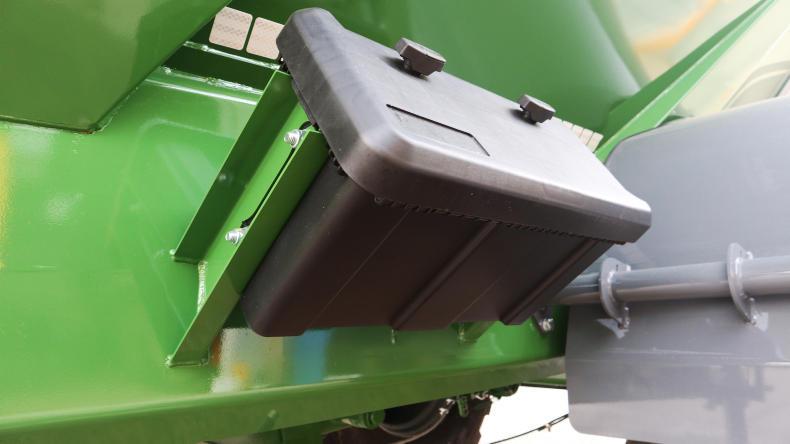
Another standard feature includes the sloped storage box.
Model range
At present, Spreadpoint is manufacturing two models – the SP400 (4m3 capacity) and the SP600 (6m3 capacity). The SP400 is the more basic model and is fitted with a land drive belt control system. This two-speed gearbox connects the tyre speed directly to the belt speed in order to achieve the application rate required. The application rate is set from the height of the back door. The SP400 comes on a 10-stud axle with hydraulic brakes only.
Richard told the Irish Farmers Journal the company is currently working on a SP900, a larger 9m3 machine.
Although these machines are currently only recommended for spreading lime, ongoing fine-tuning and testing will see these machines capable of accurately spreading fertiliser in the next five years.
SP600 specifications
Capacity: 6m3 (6,000 litre).Unladen weight: 3,000kg.Axle: 10-stud commercial (50km/h rated).Brakes: Air and hydraulic.Tyre size: 710/50R26.5.Rear door: Hydraulic.Belt drive: Hydraulic.Price: £30,000 plus VAT.
The back door is opened and closed hydraulically.
Co Down father and son team Noel and Richard Kane have started up a business making lime spreaders, called Spreadpoint.
Richard said they chose lime spreaders for a number of reasons. Firstly, they were looking out for a lime spreader for their own arable farm. After taking a look at what was on the market and what machines local agricultural contractors were using, they felt there was a gap in the market for a robust, well-designed and affordable lime spreader.
The pair, who are part of a well-know family that make trailers, also run a 1,000ac arable farm. Richard said they wanted to establish a micro-business to concentrate on in the quieter months of the year while providing the farm staff with full-time employment.
Timeline
Carrying a wealth of knowledge from the Kane family’s trailer engineering background, Noel and Richard decided to build a lime spreader two-and-a-half years ago. Eighteen months later they had designed and manufactured their first spreader.
Noel, Richard and their team have spent the past year fine-tuning the machine along with making design changes. The company has made seven spreaders to date.
Design
The spreader has a monocoque design, in that the chassis is integrated into the body. This is in an attempt to eliminate any flat surfaces, ensuring all material is sloping into the walking floor while also giving an added strength-to-weight ratio. The company opted for a 30° incline on the belt (higher to the rear of the spreader). This was to keep the centre of gravity as low as possible.
Richard said: “The belt will transfer the lime to the discs at the same efficiency at 30° as at 0°.”
Hydraulic drive
After opting for a land drive belt control system on the flagship model, Richard changed his mind and decided to use a hydraulic drive instead.
The hydraulic disc drive allows the tips of the flights to overlap between both spreading discs, increasing spreading width of lime up to 12 metres. There are four vanes per disc with each disc measuring in at 990mm (including the flights).
The beefy hydraulic disc unit has two 6mm stainless steel discs which are mounted on a synchronised gearbox and driven from one hydraulic motor.

Both 6mm stainless steel discs are mounted on a synchronised gearbox and driven from one hydraulic motor.
The discs are submerged in a bath of oil for continuous lubrication.
Nylon sleeve
The rollers for the floor have a unique bearing-less and boltless design. Instead of opting for the standard bearings on each roller, Richard decided to use 20 individual nylon sleeves which rotate on 32mm stainless steel rods. These nylon sleeves slot into the chassis of the spreader. In turn, only the nylon sleeves rotate as the belt rotates. These rollers are positioned close together to ensure the floor will rotate as soon as the hydraulics are engaged. Richard said he went for this system in an attempt to reduce downtime.
The only bearings on the moving floor are on the front and rear tensioning rollers. There are a total of nine bearings on the machine which should be greased after every 50 hours of use.

The only bearings on the moving floor are on the front and rear tensioning rollers.
RDS Apollo terminal
Richard opted to use the well-established RDS Apollo control terminal.
When connected to its own GPS receiver, this computer system will monitor the tractor’s forward speed and match the belt speed accordingly in order to reach the desired application rate.
The disc speed can also be set or adjusted from the control monitor
This target rate can be set and altered from the control monitor. The disc speed can also be set or adjusted from the control monitor.
By means of calculating what tonnage was initially loaded and what was spread from the set application rate, the terminal will also inform the operator how much lime is remaining in the spreader. The spreader is also compatible with all certified Isobus control terminals.
A button from the Apollo terminal can be retrofitted to the gearshift of the tractor. This button will trigger the belt to be engaged or disengaged. It is very handy for shutting off the supply to the discs while approaching a headland.
Features
The flagship model has a hydraulic back door to ensure no waste of material while loading or in transport. Once the door is preset, even when closed for loading or transport, it will return to its preset height.
One interesting feature is the hitch on the rear of the spreader underneath the discs. This hitch was added specifically for the Northern Irish and Scottish markets where many farmers pull elevators behind spreaders on the road.

The hitch was added specifically for the Northern and Scottish markets where many farmers pull elevators behind spreaders on the road.
The spreader comes with a smooth belt in order to provide a consistent flow of material to the discs. However, it comes with the option of a cleated belt. Richard said they have used the machine to spread chicken litter on their home farm.
The SP600 comes as standard on a Granning commercial axle rated for a maximum speed of 50km/h. This has air and hydraulic brakes. The machine is equipped as standard with 710/50R26.5 tyres. It also has a sprung drawbar system.

A nice feature is the two windows at the front of the machine. This allows the operator see into the hopper.
Other nice features include the steps either side of the sprung drawbar on to a platform, two windows at the front of the machine allowing the operator to see into the hopper, and a sloped storage box.

Another standard feature includes the sloped storage box.
Model range
At present, Spreadpoint is manufacturing two models – the SP400 (4m3 capacity) and the SP600 (6m3 capacity). The SP400 is the more basic model and is fitted with a land drive belt control system. This two-speed gearbox connects the tyre speed directly to the belt speed in order to achieve the application rate required. The application rate is set from the height of the back door. The SP400 comes on a 10-stud axle with hydraulic brakes only.
Richard told the Irish Farmers Journal the company is currently working on a SP900, a larger 9m3 machine.
Although these machines are currently only recommended for spreading lime, ongoing fine-tuning and testing will see these machines capable of accurately spreading fertiliser in the next five years.
SP600 specifications
Capacity: 6m3 (6,000 litre).Unladen weight: 3,000kg.Axle: 10-stud commercial (50km/h rated).Brakes: Air and hydraulic.Tyre size: 710/50R26.5.Rear door: Hydraulic.Belt drive: Hydraulic.Price: £30,000 plus VAT.
The back door is opened and closed hydraulically.







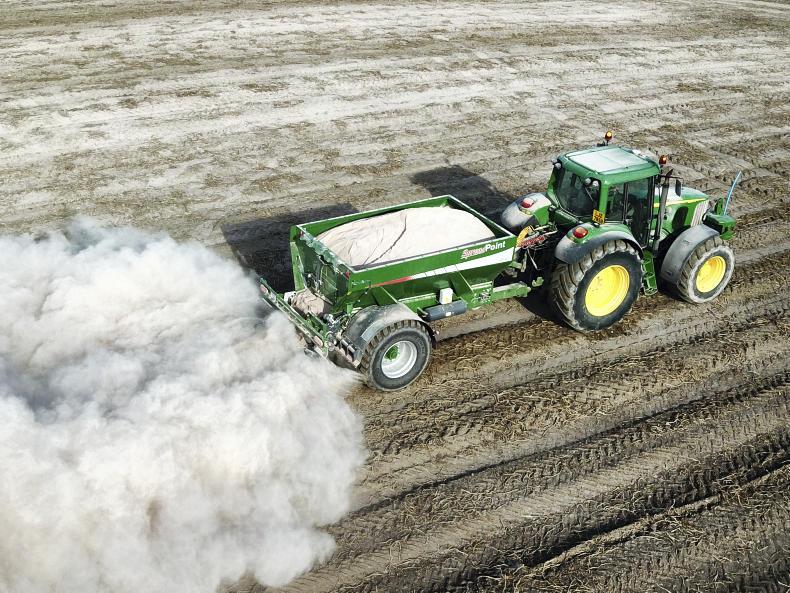




 This is a subscriber-only article
This is a subscriber-only article








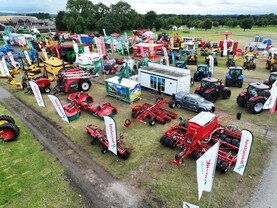

SHARING OPTIONS: